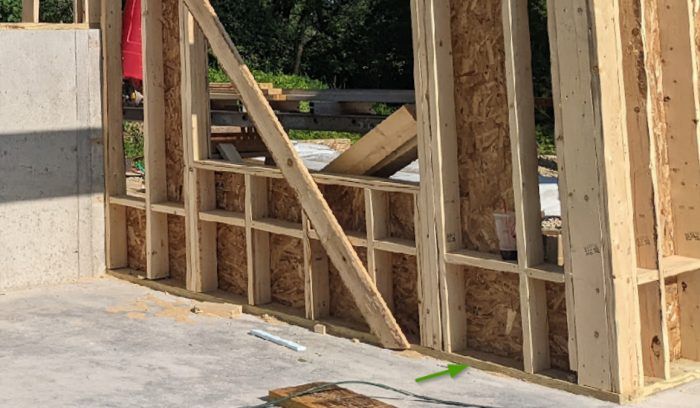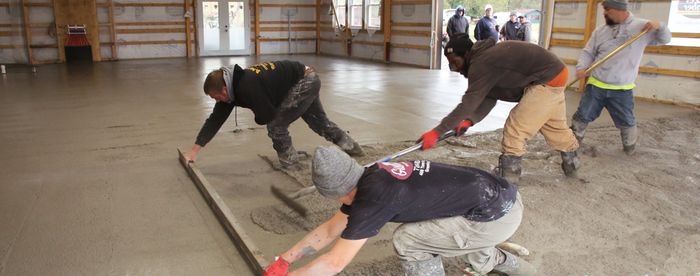Dealing with a Faulty Basement Slab
A homeowner weighs the merits of repair or replacement of a concrete slab that was poorly installed.

Bulrush is watching as his new home is being built, and things went only as far as the basement slab before problems cropped up.
“The slab has multiple issues, both errors and general poor-quality work,” Bulrush writes in this recent Q&A post. “I’m looking for opinions on how serious the various issues are, whether mitigation options exist, and whether I should push for the entire slab to be torn up and replaced.”
According to the specs, a slab of between 3-1/2 in. and 4 in. was to be poured over 2 in. of extruded polystyrene foam and a polyethylene vapor barrier. For starters, the concrete sub used 4-mil poly, not 6-mil poly, raising concerns over the long-term durability of the plastic.
The slab is not flat, Bulrush adds, with a noticeable variation across the entire slab and “significant variation” across small distances. He wonders how this will affect the luxury vinyl plank flooring he hopes to install.
Nor does the concrete have the fiber reinforcement that was called for. “I also suspect the concrete mix had a lot of water,” Bulrush says, “based on the amount of uncontrolled cracks and unevenness of the slab. The concrete sub poured the slab when temperatures ranged into the high 80s and low 90s (°F) but didn’t take any steps to keep the concrete damp as it cured.”
There’s more. Multiple pipe penetrations are completely cracked through the concrete so the pipes can now be wiggled. Power-screeding seems to be of poor quality with many areas showing concentric arcs—not only visually, but actual ridges.
Bulrush is considering the steps he’d have to take to fix the problems, including grinding the floor flat, filling cracks with polyurethane, and applying some kind of vapor barrier on top of the slab. What else can he do?
That’s where we start this Q&A Spotlight.
The “tear it out” option
Bing 0328, a general contractor for 30 years, doesn’t mince words:
“I use subs whose quality far exceeds minimums,” he says. “That’s just the way I do things. Those same subs know if it isn’t done right it gets redone. I would tell the GC to have it torn out and done right. Hope you haven’t made any payments yet, that’s your leverage.”
CT Yankee, who has been in the concrete industry for a half-century, agrees. He guesses that the concrete sub was in over his head, or was never made aware of the specs.
“If it were my house and if I know that the concrete sub was fully aware of the specs up front, then it’s a no-brainer do-over,” Yankee says.
If the general contractor was responsible for hiring the concrete sub and directing his work, then the GC now has the burden of making it right, he adds.
Bulrush says that while a tear-out may look like the most logical option, it has its downsides. For one, the delay would mean that he loses his place on the framer’s schedule. “I also probably burn some of my ability to insist on fixes later in the build,” he adds, “not contract-wise, but I don’t see a happy ending if the working relationship is dead.”
Are there any alternatives?
Adding a new slab
CT Yankee says that grinding the slab so it’s both level and flat may not be possible without compromising its thickness.
“You may be able to achieve ‘flat’ but never really achieve ‘level,'” he says. “An alternative (if ceiling height isn’t critical) would be to put the 6-mil poly over the existing slab and then place a 4-in. minimum slab on top of it.”
The idea is appealing, but there are some obstacles. The new layer of concrete would cover the bottom plates of steel columns used to support the first-floor framing. And some of the exterior walls are built at slab level for a walkout basement, so a full 4 in. of new concrete would completely cover the existing bottom plate.
“Sounds like the framers are already at work,” CT Yankee replies. “Do the columns have the screw adjustment at the bottom? Perhaps they can be inverted to put the screw adjustment at the top. Very often I see lally columns whose bases are fully encapsulated by the floor slab concrete. Not a problem until they rust to the point of requiring replacement (seen that as well).”
Adding a leveling compound
Bulrush also is thinking about a self-leveling material on top of the existing slab to even up inconsistencies and provide a flat surface for the finish floor. He’s thinking specifically about products made by Ardex, as described at this website.
“Seems like something like that would at least result in a flat and level floor, which is the most immediate problem,” he says.
CT Yankee, however, argues against an epoxy slab coating. “It may left over time or not cure properly,” he says. “As I mentioned previously, a full do-over would be best.”
Our expert’s opinion
Mike Guertin added these thoughts:
I’m sorry to hear about the problem. It’s frustrating that even with the specifications spelled out, the requirements were not met. I wonder if the floor finishers were experienced with placing concrete over plastic. It can be a tricky process, especially if water is added to the concrete. Excess water has to bleed and dry off the top instead of draining through the bottom into the soil beneath. Excess water makes finishing more time consuming and difficult. That’s not to give the concrete crew an excuse—they and the builder should have known what precautions to take and what skills were needed for a successful job.
I don’t think the 4-mil poly will deteriorate and lose its effectiveness at resisting water-vapor transmission. Since you have 2 in. of XPS beneath the plastic, I think the vapor transmission through the foam-and-plastic sandwich will be slight. And the small amount of moisture that does make it through can be handled with periodic ventilation and/or dehumidification.
If the concrete finishers did water down the concrete a lot (and if the surface is already showing cracks it sounds like they did), the current cracks will continue to get wider and more cracks will likely develop. Current and future cracks will telegraph through any applied concrete surfacer and that may be a problem for some finish flooring materials applied directly over the slab.
The other remedy solutions that have been offered—removing and placing an entirely new concrete slab and placing a thin slab over the existing one—are viable choices. If you opt to place a new slab over the old then adding a layer of plastic or other membrane to decouple the old slab from the new one will reduce the chance for cracks to telegraph through.
Another option to provide a good base for flooring is to overlay the slab with two layers of Advantech sheathing screwed together. The work can be done anytime so it won’t interfere with the framing operations; and the sheathing can bridge over gentle humps and dips so the existing slab only needs spot treatment and not a full resurfacing. The slab doesn’t need to be perfectly level, unless that’s of paramount importance to you. The ridges and small high spots can be knocked down with a grinder and low spots can be filled with self-leveling concrete surfacer made to fill to a feather edge. Cracks that propagate through spot leveler won’t matter since the sheathing will cover them. Any type of flooring—including ceramic tile, LVT, laminate, and engineered wood—can be installed over the subfloor sheathing.
Scott Gibson is a contributing writer at FHB and Green Building Advisor. Mike Guertin is a Rhode Island builder and an editorial adviser at FHB. Reader comments may have been edited for clarity.
RELATED STORIES
- Concrete: Summer vs. Winter Mixtures
- Fixing Concrete Cracks—Basement Slab Repair
- A Wood Floor that Can Survive Anywhere
Fine Homebuilding Recommended Products
Fine Homebuilding receives a commission for items purchased through links on this site, including Amazon Associates and other affiliate advertising programs.

Plate Level

Smart String Line

100-ft. Tape Measure





